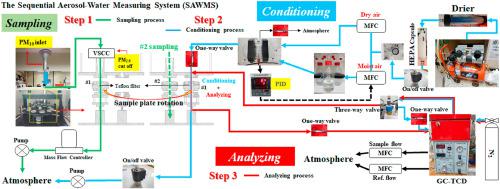Atmospheric Environment ( IF 4.2 ) Pub Date : 2021-08-17 , DOI: 10.1016/j.atmosenv.2021.118671 Shao-En Sun , Shih-Yu Chang , Chung-Te Lee

|
Aerosol water content (AWC) is associated with aerosol formation, aerosol–cloud interaction, and atmospheric visibility degradation; however, few studies have directly measured the mass of water in aerosols. Studies on AWC have employed modeling techniques [e.g., ISORROPIA II and the Extended Aerosol Inorganics Model (E-AIM) III)], the thermal-ramp Karl-Fisher method, and conducted volume-based measurements by using a hygroscopic tandem differential mobility analyzer (H-TDMA). The current study developed a sequential aerosol-water measurement system (SAWMS) that sequentially collects particles with up to 10 filters and measures AWC immediately after the collection. With this system, the loss of semi-volatile species was lower, and contamination during sample transport was reduced. The AWC measurement results were validated by comparing them with modeling results obtained in this study and the results obtained in previous studies. The measurement results for three aerosolized salts—NaCl, NH4NO3, and (NH4)2SO4—were found to be in favorable agreement with the corresponding modeling results and results from previous studies. The relationship between aerosol mass change (AMC) and relative humidity (RH) was investigated. The deliquescence RH (DRH) was 75%, 63%, and 81% for NaCl, NH4NO3, and (NH4)2SO4, respectively, whereas efflorescence RH was observed only for NaCl at 40%–50% RH. The AWC of mixed inorganic salts exhibited weak mutual DRH at 45%–50% RH. By contrast, the AWC obtained using ISORROPIA II and E-AIM III exhibited a gradual rather than an abrupt change of RH upon deliquescence. The measured AWC values were more similar to the values obtained with ISORROPIA II than to the values obtained with E-AIM III. To compare our mass-based measurements with the volume-based measurements obtained in previous studies using H-TDMAs, we derived the relationships of hygroscopicity parameter and growth factor with AMC. We discovered that the aforementioned relationships were comparable. In summary, the developed SAWMS integrates a sequential aerosol collection device with a gas chromatograph equipped with a thermal conductivity detector; the system performs well in the quantification of AWC and provides an additional chance of the filter for further chemical analysis.
中文翻译:

连续气溶胶-水测量系统的开发和评估
气溶胶含水量 (AWC) 与气溶胶形成、气溶胶-云相互作用和大气能见度下降有关;然而,很少有研究直接测量气溶胶中水的质量。对 AWC 的研究采用了建模技术 [例如 ISORROPIA II 和扩展气溶胶无机模型 (E-AIM) III)]、热梯度卡尔费休方法,并通过使用吸湿串联差分迁移率分析仪进行基于体积的测量(H-TDMA)。目前的研究开发了一种连续气溶胶-水测量系统 (SAWMS),该系统可以使用多达 10 个过滤器连续收集颗粒,并在收集后立即测量 AWC。使用该系统,半挥发性物质的损失更低,样品运输过程中的污染也减少了。通过将 AWC 测量结果与本研究中获得的建模结果和先前研究中获得的结果进行比较,验证了 AWC 测量结果。三种雾化盐——NaCl、NH的测量结果4 NO 3和(NH 4 ) 2 SO 4 -被发现与相应的建模结果和先前研究的结果一致。研究了气溶胶质量变化 (AMC) 与相对湿度 (RH) 之间的关系。NaCl、NH 4 NO 3和(NH 4 ) 2 SO 4的潮解RH (DRH)分别为75%、63%和81%,而仅在 40%–50% RH 的 NaCl 中观察到风化 RH。混合无机盐的 AWC 在 45%–50% RH 下表现出弱的相互 DRH。相比之下,使用 ISORROPIA II 和 E-AIM III 获得的 AWC 在潮解时表现出逐渐而不是突然的 RH 变化。与使用 E-AIM III 获得的值相比,测量的 AWC 值更类似于使用 ISORROPIA II 获得的值。为了将我们基于质量的测量结果与之前使用 H-TDMA 获得的基于体积的测量结果进行比较,我们导出了吸湿性参数和生长因子与 AMC 的关系。我们发现上述关系具有可比性。总之,开发的 SAWMS 将连续气溶胶收集装置与配备热导检测器的气相色谱仪集成在一起;











































 京公网安备 11010802027423号
京公网安备 11010802027423号